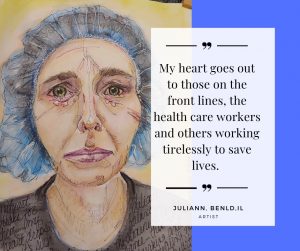State museum collecting COVID-19 stories to archive pandemic in real time
By Tim Alexander for Chronicle Media — April 23, 2020
The Illinois State Museum in Springfield and all all state museums are currently closed to the public due to the COVID-19 outbreak. The state museum is encouraging residents to share their stories of life in the pandemic. (enjoyillinois.com)
An online initiative has been launched by the Illinois State Museum for Illinois residents to share artifacts, narratives, art and remembrances related to the COVID-19 pandemic.
The museum’s “Share Your Story: Illinois in the COVID-19 Pandemic” collection, launched around three weeks ago, has already received several contributions from Illinois residents affected in various ways by the novel coronavirus, according to Erika Holst, Illinois State Museum curator of history.
“We want to hear from people in their own words, because everyone’s life has changed from one month ago. With everyone being affected by the pandemic, every individual story and experience is valuable,” said Holst, adding that the offerings that have trickled in since the museum announced the initiative on April 6 have come in a variety of formats.
“We want everyone to tell their story in the format that makes the most sense to them,” she said. “You can write a poem and upload a Word document, or snap a picture. You can send in artwork; some people have sent in original comics they have drawn. You can also upload a digital file to our website.”
The museum is currently unable to accept digital video or audio files due to storage capacity restrictions. For now, only documents, photos and images are being accepted. In whatever manner the contributions arrive, Holst feels each will be of significant value to future generations.
“For future generations, these are really going to help flesh out what we knew about the pandemic, including the numbers on how many were ill, how many lost their jobs, and their lives. But what history doesn’t always record is the human experience behind (the numbers), what people think and feel, how they lived. We want people to provide that context so we can save it for the future to provide people with education and inspiration,” Holst said.

An example of an artwork contribution an Illinois resident has shared with the Illinois State Museum COVID-19 collection initiative. (Photo courtesy of Illinois State Museum Facebook)
The Illinois State Museum was founded in 1877, well before the Spanish flu pandemic killed around 675,000 Americans, including thousands of Illinoisans, between 1918-1920. The similarities between public reaction to the Spanish flu and COVID-19 pandemics — down to the banning of public gatherings, funerals and visitations in Illinois — are striking.
The museum’s digital archives hold many articles and photographs related to Illinois in the Spanish flu era, including those illustrating the pandemic’s effect on soldiers at Chanute Air Base and the selfless acts of medical professionals, nurses and volunteers. The “Share Your Story: Illinois in the COVID-19 Pandemic” collection will serve as a similar patchwork mosaic of artifacts and testimonials for those looking back at how Illinois experienced the novel coronavirus a century from now, museum officials hope.
“There were many similarities in the way the Spanish flu shut down society and changed people’s habits. For instance, people back then used to chew a lot of tobacco, but that stopped during that pandemic because they didn’t want people spitting on the streets. But this was not in any of our lifetimes, so it is all uncharted territory for us,” said Holst. “We want to ensure the small things are preserved.”
However, a lot has changed as to how society was able to react to each pandemic, Holst noted. Modern medicine, technology and social media has greatly enhanced worldwide reaction to the threats presented by the COVID-19 virus, compared with the Spanish flu. “We’ve been able to recreate society online, and attempt to replace the things we lost in the virtual world,” she said. “It will be interesting to (document) how that unfolds.”
Over 150 submissions had been received from Illinoisans for the museum’s COVID-19 initiative as of April 15, Holst reported, from the Chicago region to southern Illinois. “We’ve got contributions from health care professionals, retirees, high school and grade school students– it’s running the gamut. We want everyone to contribute,” she said.
“What’s really amazing to see is the beautiful resilience of the human spirit that comes through. You can definitely sense people’s fear and anxiety and sadness, but you can also see the desire to connect to people and form bonds to help each other through this,” Holst continued. “Even though there is physical distance, there is still an emotional closeness between people.”
HOW TO CONTRIBUTE
To contribute to the Illinois COVID-19 collection initiative, visit the Illinois State Museum’s website, www.illinoisstatemuseum.org to upload files and documents.
Similarly, other states are seeking COVID-related items from residents for preservation. The Indiana Historical Society is urging residents to contribute items, including short videos, to its 190-year-old collection via its website, www.indianahistory.org.



